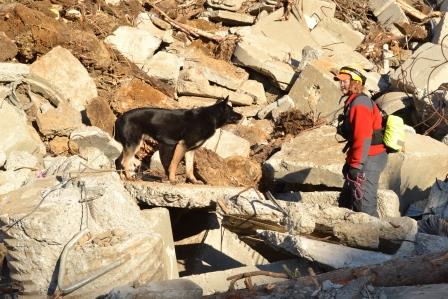
Home > Dispatches > Daily Dispatches 2014 > Daily Dispatch #87
March 28, 2014: Dog Training: Disaster Relief Training
There was a formal demolition site training today at the Alaska Demolition site. Originally, search and rescue dogs from Washington and California were to come up here and train. But there was a change in plans a few days ago. No dogs materialized – most are doing search and rescue work in Oso, WA, where the mudslide occurred. Instead, it became a Mat Sar K-9 training session, one that was led by Anchorage-based Asard member Dolly Leferve. She was the woman who summited seven of the world’s tallest peaks. |
|
| The training took place in the demolition pit – a three sided rubble amphitheater. We were surrounded on three sides by fifty foot high walls of dirt and concrete rubble. Up above, to the left, a loader was moving debris. On all sides were concrete slabs of varying sizes, and rebar. Lots of rebar. This was adjacent to a gravel pit, where every so often, there was small rock slide type avalanches. The dogs were all first acquainted with the rubble, and encouraged to walk on it off lead. This is because stuff could get caught up in their collars. Then the Mat SAR Tier I dogs, that is those with the most training, were worked. They found subjects who were in the rubble caves that had been constructed the previous day by Steve, one of the Alaska Demolition employees. Donna’s dog Kip and Patty’s dog Abbey did well. Tya, Vikki’s dog, was a bit more unsure of herself. It was then time to work the younger dogs. Tara, Kathy’s dog, had no problem finding the subject and getting into a cave. As Cathy rightly said later, Tara was brave. Ryder was next up. Ryder (off leash, an accomplishment in itself) went to the subject and then, after realizing she had to climb up a slab, backed off. The subject who was in a plywood covered hole, repeatedly called her and waved her tug toy. Ryder finally made it to him, and they played for a bit. After, Stacie worked her dog Mica, who too felt comfortable on the rubble. Dolly then encouraged us all to play on the rubble with our dogs. She added that this was a good idea because they’d then become more comfortable about doing searches on uneven surfaces. I clambered up the concrete chunks, and onto a flat, table-like piece. Ryder was adept at moving about on the debris, but because she was nervous, she wasn’t too keen about playing tug. Donna, who agreed to assist me, wisely suggested that we chunk things down some – so we first had Ryder find me on level ground, and in sight, then find me on the lower level rubble. Then, I climbed back where I was before. This time, she did just fine. The very valuable life lesson here was, if the dog doesn’t get it, go back to kindergarten and make things easier, then work your way back up to first grade. The second valuable life lesson was that Ryder is learning at her own pace. The third valuable life lesson was that Ryder (as do all the dogs) has her own support network. This (right now) consists of Stacey Re, Kathy Day, Donna Cramer, and Jim Maddry. All have been supportive and generous when it comes to Ryder’s training. I would not know what I now know about this kind of training if it weren’t for all of them. Dolly also worked Shadow, her sixteen-month old border collie. He’s a larger version of Ryder – he sort of looks like a Dutch belted cow – he has a wide band of white around his middle. He does have the same sweepy, plume-like tail, and also Ryder’s same way of moving. It seemed to me that his focus comes and goes, just as hers does. After this training, Pete, Kathy, and I went to the Matanuska River Park where Pete first walked a three quarters of a mile trail for Tara and Kathy. Kathy had wisely decided to use clip flags, which Pete, as he walked along, attached to trees. The hope was that Kathy and I (I was the support person) would more easily find our way where we were going, with the expectation that Tara would have a clean run. This is exactly what happened. Tara moved with considerable self-assuredness and found Pete in short order. Lastly, we did three short sessions with Ryder. I was the subject the first two times and Kathy was the subject the third time. All day, Ryder had been intent on playing tug, but then, when she found me, she seemed to lose interest. So Kathy suggested that I use treats. This worked. We ended Ryder’s work day with a vigorous tug session. Now I know that finds must culminate in this activity, for the dog needs to be rewarded for engaging in hard work. |
|
